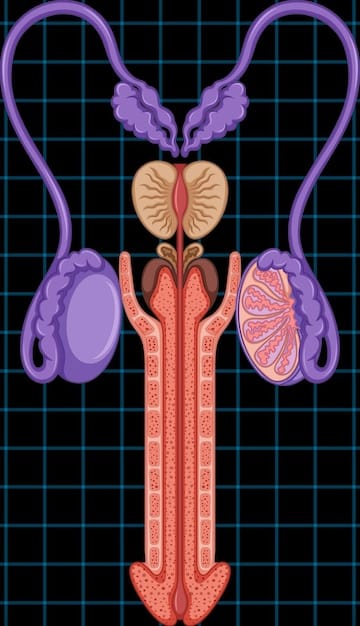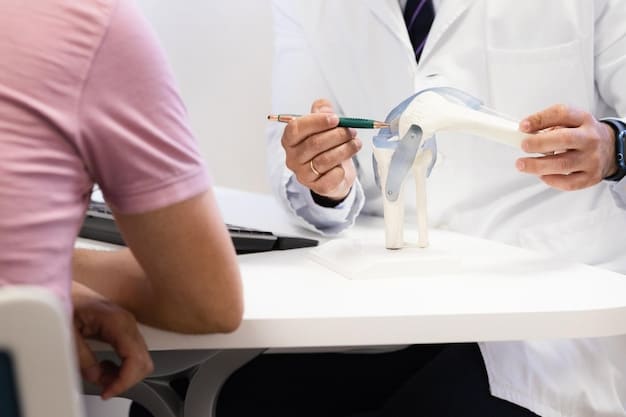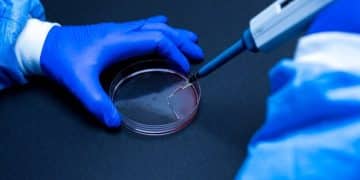Enlarged Prostate: FDA-Approved Treatments for 2025 You Need to Know

Enlarged prostate, or benign prostatic hyperplasia (BPH), affects many men, and the FDA is expected to approve new treatments by 2025, offering hope for improved symptom management and quality of life.
Dealing with an enlarged prostate? Enlarged Prostate: New FDA-Approved Treatments for 2025 You Need to Know, offering innovative solutions to improve men’s health and well-being. Keep reading to discover advancements and manage BPH.
Understanding Enlarged Prostate (BPH)
Benign Prostatic Hyperplasia (BPH), or enlarged prostate, is a common condition affecting older men. It involves the non-cancerous growth of the prostate gland, which can lead to various urinary symptoms.
Understanding BPH is the first step toward managing it effectively. Let’s explore the basics of this condition.
What is BPH?
BPH is characterized by the enlargement of the prostate gland. This growth can compress the urethra, the tube that carries urine from the bladder, leading to urinary difficulties.
Common Symptoms of BPH
The symptoms of BPH can vary in severity but commonly include:
- Frequent urination, especially at night (nocturia)
- Urgency to urinate
- Weak urine stream
- Difficulty starting urination
- Dribbling after urination

These symptoms can significantly impact a man’s quality of life, making daily activities challenging. Recognizing these signs is crucial for early diagnosis and treatment.
Understanding the basics of BPH, including its definition and common symptoms, is vital for managing the condition effectively and seeking appropriate treatment. Early diagnosis can lead to better outcomes and improved quality of life.
Current Treatment Options Available
Several treatment options are currently available for managing BPH, ranging from lifestyle changes and medications to minimally invasive procedures and surgery. The choice of treatment depends on the severity of symptoms and the individual’s overall health.
Exploring these options can help men make informed decisions about their care. Let’s delve into the existing treatments.
Medications for BPH
Here are some common medications used to treat BPH:
- Alpha-blockers: Relax the muscles in the prostate and bladder neck to improve urine flow.
- 5-alpha reductase inhibitors: Shrink the prostate gland by blocking the hormone that causes its growth.
- Combination therapy: Combines both alpha-blockers and 5-alpha reductase inhibitors for comprehensive symptom relief.
Minimally Invasive Procedures
These procedures offer alternatives to traditional surgery, often with shorter recovery times:
- Transurethral Microwave Thermotherapy (TUMT): Uses microwave energy to heat and destroy excess prostate tissue.
- Transurethral Needle Ablation (TUNA): Uses radiofrequency energy to ablate prostate tissue.
- UroLift System: Lifts and holds the enlarged prostate tissue out of the way, relieving pressure on the urethra.

These therapies offer hope for managing BPH without major surgery. Discussing these options with a healthcare provider can help determine the best course of action.
Current treatment options for BPH include medications and minimally invasive procedures. These treatments aim to alleviate symptoms and improve urinary function, helping men manage their condition effectively.
FDA Approval Process Explained
Understanding the FDA approval process is crucial for knowing how new treatments for enlarged prostate become available. This process ensures that approved medications and medical devices are safe and effective for use.
Let’s take a closer look at the steps involved in the FDA approval process.
Stages of FDA Approval
The FDA approval process typically involves several stages:
- Preclinical Research: Initial laboratory and animal testing to assess safety and potential efficacy.
- Clinical Trials: Conducted in phases to evaluate safety, dosage, and effectiveness in humans.
- FDA Review: Submission of data to the FDA for review and assessment.
- Approval: If the FDA determines that the benefits outweigh the risks, the treatment is approved for use.
Significance of FDA Approval
FDA approval signifies that a treatment has been rigorously tested and evaluated, meeting the agency’s standards for safety and efficacy. This ensures that healthcare providers and patients can trust the treatment.
The FDA approval process is a rigorous and essential pathway for bringing new, safe, and effective treatments to market. It provides assurance that approved options have been thoroughly evaluated, benefiting both healthcare providers and patients.
Potential New Treatments on the Horizon for 2025
Looking ahead to 2025, several promising new treatments for enlarged prostate are on the horizon. These potential advancements aim to improve efficacy, reduce side effects, and offer more personalized approaches to managing BPH.
Let’s explore some of the exciting developments expected in the coming years.
Advanced Drug Therapies
Researchers are developing new drug therapies that target the underlying causes of BPH with greater precision. These may include:
- Selective alpha-blockers with fewer side effects
- Novel 5-alpha reductase inhibitors with improved efficacy
- Medications that target specific growth factors involved in prostate enlargement
Innovations in Minimally Invasive Procedures
New minimally invasive procedures are being developed to provide more effective and less invasive alternatives to traditional surgery:
- Robotic-assisted procedures for greater precision and reduced recovery time
- Laser therapies that target and remove excess prostate tissue more effectively
- Advanced implants that provide better support and relief of urinary symptoms
The future of BPH treatment looks promising, with innovations in drug therapies and minimally invasive procedures offering new hope for improved outcomes and quality of life.
Benefits of Early Diagnosis and Treatment
Early diagnosis and treatment of enlarged prostate are essential for preventing complications and improving long-term outcomes. Recognizing the symptoms early and seeking timely medical attention can make a significant difference in managing the condition.
Let’s explore the advantages of addressing BPH promptly.
Preventing Complications
Early treatment can help prevent several complications associated with untreated BPH, including:
- Urinary retention: Inability to empty the bladder completely
- Urinary tract infections (UTIs): Increased risk due to urinary stasis
- Bladder damage: Over time, the bladder can weaken and lose its ability to contract
- Kidney damage: In severe cases, backflow of urine can damage the kidneys
Improving Quality of Life
By addressing BPH early, men can experience significant improvements in their quality of life, such as:
- Better sleep: Reduced nocturia leads to more restful nights
- Increased comfort: Fewer urinary symptoms mean less discomfort and inconvenience
- Improved confidence: Managing urinary issues can boost self-esteem
- Enhanced daily activities: Less frequent and urgent urination allows for more freedom
Seeking early diagnosis and treatment for enlarged prostate can help prevent complications and significantly improve quality of life. Addressing the condition promptly leads to better health outcomes and overall well-being.
Lifestyle Adjustments to Manage BPH Symptoms
In addition to medical treatments, certain lifestyle adjustments can help manage the symptoms of enlarged prostate. These changes can provide relief and improve overall urinary health, complementing medical interventions.
- Limit fluid intake before bedtime: Reduces nighttime urination.
- Avoid caffeine and alcohol: These can irritate the bladder and increase urinary frequency.
- Practice double voiding: Empty the bladder completely by waiting a few moments and trying again.
- Stay physically active: Regular exercise can improve urinary function..
Integrating these lifestyle adjustments into daily routines can offer practical support in managing BPH symptoms. Combining these changes with medical treatments can enhance overall effectiveness and improve quality of life.
| Key Point | Brief Description |
|---|---|
| 👨⚕️Understanding BPH | Recognizing the symptoms and seeking early diagnosis. |
| 💊 Current Treatments | Exploring medications and minimally invasive procedures. |
| 🔬 FDA Approval | Ensuring treatments are safe and effective. |
| 🏃Lifestyle Changes | Adjustments like limiting fluids, reducing caffeine, and staying active. |
Frequently Asked Questions (FAQ)
▼
Benign Prostatic Hyperplasia (BPH) is an enlargement of the prostate gland. Common in older men, it can cause difficulty with urination.
▼
Common symptoms include frequent urination, especially at night, urgency, weak urine stream, difficulty starting urination, and dribbling after urination.
▼
BPH is typically diagnosed through a physical exam, urine tests, prostate-specific antigen (PSA) blood test, and possibly a digital rectal exam (DRE).
▼
Potential new treatments include advanced drug therapies and innovations in minimally invasive procedures, like robotic-assisted surgeries and laser therapies.
▼
Yes, lifestyle changes such as limiting fluid intake before bed, avoiding caffeine and alcohol, practicing double voiding, and staying physically active can help.
Conclusion
As we look towards 2025, the landscape of BPH treatment is set to evolve with new FDA-approved options that promise to enhance the quality of life for many men. Keeping abreast of these advancements and consulting with healthcare professionals ensures informed decisions about managing enlarged prostate.





